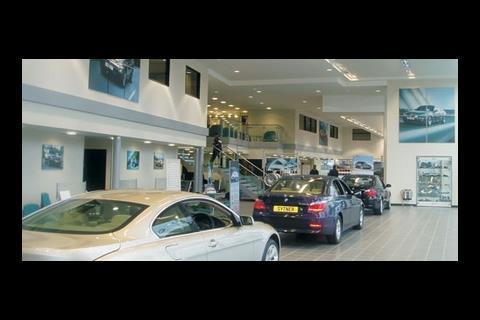Those temples to the automobile can be lavish enterprises, with double-height glazing, blazing lights and costly stone floors. And that’s before you even get into the realms of internet cafes and branded clothing. Maxwell Wilkes of Davis Langdon offers an unbeatable all-in price
01 Introduction
A car is one of the most expensive purchases a person makes and today’s showroom has an important role in helping customers make that decision.
In an increasingly segmented market, an outlet needs to cater for a range of clients and their needs.
In today’s brand-driven society, cars and lifestyle overlap and the sales environment should reflect the customer’s preferences.
The scope of a car dealership scheme is not limited to sales. After-sales service is an element of the business model so a service reception and a parts and workshop facility are often located on a showroom site.
At prestige outlets, customers may have access to refreshments, wireless or internet connections in coffee bars or lounges.
02 Design considerations
Car showrooms need to be located on highly visible sites with good access to main transport routes and an eye-catching frontage. Display of the car range is paramount and the layout and orientation of sites and display areas will have a major impact on sales.
These considerations affect environmental control strategies, as not all buildings can be oriented to mitigate solar gain and heavily tinted solar control glass is not generally considered for the main facade.
As part of the fit-out, additional space may be given over to financial services companies providing loans, insurance and similar products.
The current trend is for a double-height display area with the main frontage in full-height glazing, making a design statement and providing high visibility. Glazing over 3m high does not qualify as a shopfront, which means the solar gain component must be included in Part L calculations. Furthermore, double-glazed units must be specified, rather than the clear single-glazing typical of shopfronts.
The building services standard is also high. Comfort cooling in customer areas is required to control solar gains in highly glazed areas. Showroom lighting – which reinforces brand identity, displays cars in the best light and creates the right mood – is a useful sales tool.
Many materials used in showroom construction, including cement, steel frame, metal and glazed cladding and some building services components, have been subject to volatile price changes in the past two years, introducing added risk for developers and contractors.
A further area of uncertainty relates to the introduction of Part L in 2006. For most motor dealerships, sustainability is not a major business driver, but delivering buildings that meet manufacturers’ design codes could be a challenge. Although occupancy-related cooling loads are not a major issue, loads related to solar gain are.
Measures taken to mitigate loads, energy use and carbon emissions include:
- Use of extended eaves, brise-soleil and canopies to reduce solar gain, particularly on the main facade
- Use of rooflights to provide basic levels of illumination without adding to cooling loads
- Enhanced insulation for solid cladding and roofs
- Lighting control
- Offsetting relatively high carbon emissions in a mechanically cooled showroom across the total floor area of the scheme, which includes areas such as workshops with lower loads.
The European Block Exemption rules on franchises influence the manufacturer’s specification of finishes in such businesses. Finishes are typically of high quality,
often with a stone tile floor and wall lining system. The showroom may also have a balcony or gallery.
Corporate branding by manufacturers is leading to a trend for standardised fixtures, fittings and equipment specified to meet “corporate identity standards” that turn showrooms into bespoke retail boxes. The choice of materials, such as timber flooring in lieu of tiling, is another way for a manufacturer to reinforce its visual image.
With the value of the stock on display, security is a major concern. Showrooms have comprehensive access control, alarms and sophisticated CCTV. CCTV is located internally and externally and uses infrared for night-time vision. It may feature movement tracking and link back to remote monitoring centres. Some systems feature loudspeaker systems used by remote monitoring teams to warn intruders that they are on camera.
Discreet physical security measures such as forecourt bollards and perimeter fencing are also necessary to prevent unauthorised vehicle entry and exit, but must not interfere with customer views of vehicles on display.
The external works account for a considerable proportion of overall expenditure. Forecourt sales and parking for various repairs and servicing


















